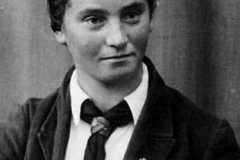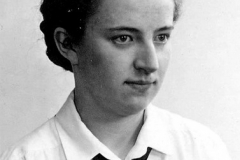If you’ve spent some time on my main website on the history of the League of German Girls, you’ve probably noticed that this is not an impression you will enjoy if you like wearing a lot of insignia, ribbons, and loads of other pins and tinnies. The BDM uniforms are very simple, and more often than not, the only insignia worn on it are the regional triangle and the Hitler Youth membership pin, and even the pin is not seen on the majority of members.
→ The Regional Triangle
→ The HJ Membership Pin
→ The HJ Cloth Insignia
→ Medical Trade Badges
→ Proficiency Badges
→ Tinnies
The Regional Triangle
 The photo on the right shows a reproduction Gaudreieck, or regional triangle, for the West Westmark region of Germany, which was made by Landser Outfitters. These triangles were regional insignia that not only tell you which area of the country the wearer was from, but also which Gau (an area equivalent to a state). As such, Ost Berlin doesn’t mean a person is from the Eastern part of Berlin, but rather from Berlin, which is part of Obergebiet (region) East.
The photo on the right shows a reproduction Gaudreieck, or regional triangle, for the West Westmark region of Germany, which was made by Landser Outfitters. These triangles were regional insignia that not only tell you which area of the country the wearer was from, but also which Gau (an area equivalent to a state). As such, Ost Berlin doesn’t mean a person is from the Eastern part of Berlin, but rather from Berlin, which is part of Obergebiet (region) East.
Gau triangles for the League of German Girls are black with white lettering, while those of the male Hitler Youth are black with yellow (some say, “khaki”) lettering. They are BeVo woven and not embroidered, and because there are few affordable quality reproductions on the market you are a bit limited in which regions you can chose from. Known reproductions are West Westmark (ours), Sued Franken, and Sued Schwaben. The Sued Schwaben triangles are often sold as originals with an RZM tag attached, but the chances that they are actually originals are slim because that particular triangle was used only from 1943 until 1945.
The triangle is to be worn on the left sleeve of the blouse as well as on the left sleeve of the brown climbing jacket. While there are no actual measurements where it should be worn, they are mostly seen centered on the upper sleeve.
The HJ Membership Pin
 The photo on the right shows the Hitler Youth membership pin, which is a small metal and enamel pin that was worn by members of the male and female Hitler Youth. The pin has a closure similar to a safety pin on the back and was worn on the left chest pocket of the white blouse, as well as on the left chest pocket of the brown climbing jacket.
The photo on the right shows the Hitler Youth membership pin, which is a small metal and enamel pin that was worn by members of the male and female Hitler Youth. The pin has a closure similar to a safety pin on the back and was worn on the left chest pocket of the white blouse, as well as on the left chest pocket of the brown climbing jacket.
Some people mistakenly consider this a Nazi party membership pin, which is, of course, wrong. It is the insignia of the Hitler Youth, not the Nazi party. However, your impression is just as correct without wearing this pin, and if any event coordinators or units give you any grief about wearing it, it’s better to just take it off than try to explain to uninformed people that this is not a Nazi party pin.
The HJ Cloth Insignia
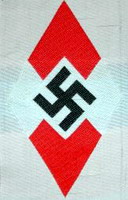 Aside from the Hitler Youth membership pin above, the insignia also existed in a BeVo woven version seen on the right. The one pictured here is an exact copy made by our insignia vendor, Landser Outfitters. This cloth insignia was worn by the male and female Hitler Youth on a variety of garments. For the League of German Girls we most commonly see them worn on the center or lower sleeve of the brown climbing jacket, and centered on the chest on sports shirts, the Belief and Beauty gymnastics dress, and the BDM medical service girls’ aprons. We also see them on other sports clothing, like hockey or ice-skating outfits, and sometimes on the lower left chest of the track suit or on BDM bathing cap covers (a black scarf worn over a white rubber bathing cap). This is probably the single most widely worn insignia aside from the Gau triangles.
Aside from the Hitler Youth membership pin above, the insignia also existed in a BeVo woven version seen on the right. The one pictured here is an exact copy made by our insignia vendor, Landser Outfitters. This cloth insignia was worn by the male and female Hitler Youth on a variety of garments. For the League of German Girls we most commonly see them worn on the center or lower sleeve of the brown climbing jacket, and centered on the chest on sports shirts, the Belief and Beauty gymnastics dress, and the BDM medical service girls’ aprons. We also see them on other sports clothing, like hockey or ice-skating outfits, and sometimes on the lower left chest of the track suit or on BDM bathing cap covers (a black scarf worn over a white rubber bathing cap). This is probably the single most widely worn insignia aside from the Gau triangles.
I realize that some people may be uncomfortable wearing a large swastika like this, even at a re-enactment, and I can certainly understand it – although I wonder a little as to why one would want to do a German impression for this time period if that’s the case. It is, however, just as correct not to have this on your uniform as it is to have it. There are a ton of photos of girls who don’t have the insignia on their climbing jacket or their sports shirts. So if you are not comfortable wearing this, you’re just as authentic without.
Medical Trade Badges
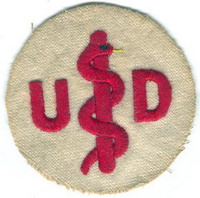 Shown in this section are two original medical trade badges that were worn by the League of German Girls which you could wear on your uniform if you’re doing the impression of a medical service girl.
Shown in this section are two original medical trade badges that were worn by the League of German Girls which you could wear on your uniform if you’re doing the impression of a medical service girl.
The insignia on the left shows a snake and staff with the letters UD, which stands for Unfalldienst, or medical service, which was the BDM’s first aid section. Girls had to pass a three-month long first aid course with a final test in order to qualify as a member of the health service. After graduating from the course they were allowed to wear the badge on the left sleeve of the blouse, usually below the Gau triangle, and on the lower left sleeve of the climbing jacket.
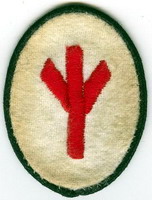 It is important to know that the Unfalldienst badge pictured above was used only until September 1938, and wearing it at an event set at a later point in time would be incorrect. After September 1938, the BDM medical service, went to a new insignia showing a red Y shaped rune, the so-called life rune, on white background. In the same year, the male Hitler Youth also changed to this new style insignia. This new insignia was worn on the left lower sleeve of the jacket, and the right chest pocket of the white blouse.
It is important to know that the Unfalldienst badge pictured above was used only until September 1938, and wearing it at an event set at a later point in time would be incorrect. After September 1938, the BDM medical service, went to a new insignia showing a red Y shaped rune, the so-called life rune, on white background. In the same year, the male Hitler Youth also changed to this new style insignia. This new insignia was worn on the left lower sleeve of the jacket, and the right chest pocket of the white blouse.
This new insignia had a surrounding border that denoted whether a girl belonged to the medical service in her local area, group, Gau, or Obergau. The basic insignia had a red and white surround, the one for Gruppe had a green and white surround; for Gau a red surround, and for Obergau a black surround as seen in the photo on the right. This insignia was also worn on the kerchief style nurse’s hat the BDM medical service girls wore, but not on the apron. Embroidered and BeVo versions of this insignia existed.
Proficiency Badges
 In 1934, the League of German Girls received its first proficiency badge, which consisted of a red-white-red ribbon behind the letters “BDM”. The lettering and frame came in bronze or silver, depending on the grade that was awarded. The bronze grade award was added in 1935.
In 1934, the League of German Girls received its first proficiency badge, which consisted of a red-white-red ribbon behind the letters “BDM”. The lettering and frame came in bronze or silver, depending on the grade that was awarded. The bronze grade award was added in 1935.
 Until 1940, the same award was used for the Jungmaedel as well, with the difference that it had a plain red ribbon in the background instead of a red-white-red one as used for the older girls. In 1940, the Jungmaedel had a new badge designed for them, which consisted of the letters JM in front of a plain red ribbon. Thereafter, the BDM proficiency award with the red-white-red ribbon was used for the older girls only.
Until 1940, the same award was used for the Jungmaedel as well, with the difference that it had a plain red ribbon in the background instead of a red-white-red one as used for the older girls. In 1940, the Jungmaedel had a new badge designed for them, which consisted of the letters JM in front of a plain red ribbon. Thereafter, the BDM proficiency award with the red-white-red ribbon was used for the older girls only.
This means, if you are doing the impression of an younger BDM girl prior to 1940, your badge needs to have a solid red ribbon in the background, but if your impression is later than 1940, you will need the JM proficiency badge. I do not know of any vendors who are currently making a reproduction of the BDM proficiency badges, and I would not suggest for anyone to wear and original since they are scarce and expensive. This is an item better left in your collection at home, or maybe displayed in a shadowbox where it will be safe and protected from the elements.
Tinnies
Aside from the insignia described above, most BDM girls didn’t wear any insignia, pins, or other symbols on their uniforms. However, there exist some photos – and you should check the portrait gallery on the main page for some of them – where girls are wearing small pins and “tinnies” from events they participated in, as well as awards they’ve earned, for example, in the national vocational competition. It is already fairly rare to see one such pin on a girl’s uniform, even rarer to see two or more, so go easy on those. Below are a few examples of pins that could be worn on the uniform.
The insignia worn are from top left to bottom right: Female version of the DRL sports badge, participant tinnie for the 1937 youth festival, BDM festival badge, regional winner’s badge for the national vocational competition, and another event tinnie / day badge.





